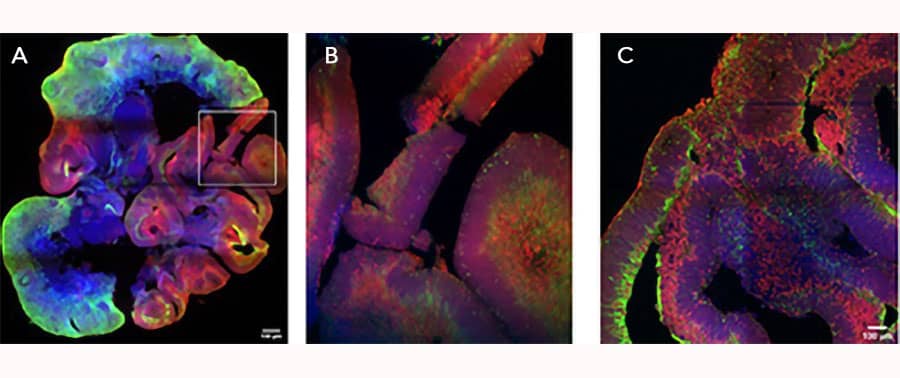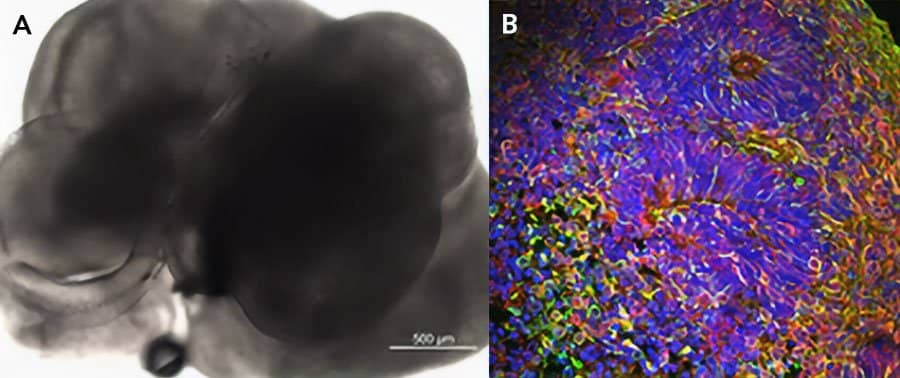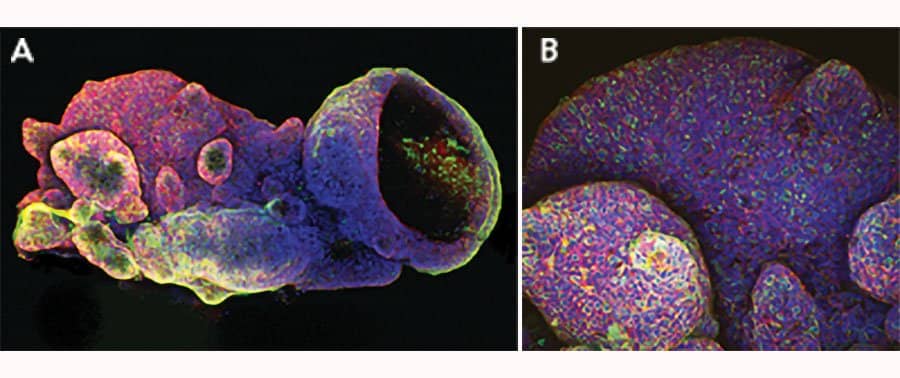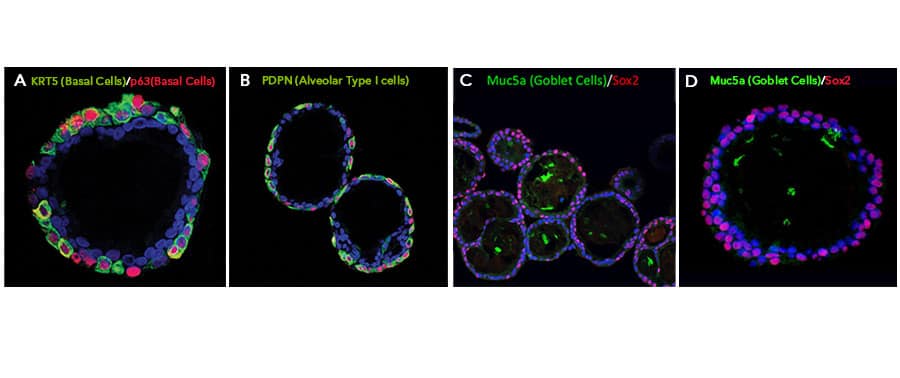|
|
Application of Y-27632 dihydrochloride in MESP1+ Mesoderm.
ROCK inhibition by Y-27632 (1 μM) promotes skeletal myogenic differentiation of MESP1+ mesoderm, as shown by immunostaining for Myosin Heavy Chain+ (Green) and Myogenin (Red), and counterstaining with DAPI (Catalog # 5748; Blue, Tocris). Data courtesy of Dr Sunny Chan and Dr Michael Kyba, University of Minnesota.
|
|
|
Application of Y-27632 dihydrochloride in Culture and Characterization of iPSC-derived Cerebral Organoids.
iPSC-derived cerebral organoids (day 45) were cultured using Cultrex UltiMatrix RGF Basement Membrane Extract (Catalog # BME001-05) and brain organoid culture medium, which includes Y-27632 dihydrochloride, along with other reagents listed in the brain organoid culture recipe. Cerebral organoids were stained for Syto6 (blue), Pax6 (red), and Vimentin (green). (A) Image taken at 4x magnification. (B) An enlarged view of the area shown within the white box in part A of the figure. (C) Image taken at 15x magnification. Images courtesy of LifeCanvas Technologies.
|
|
|
Application of Y-27632 dihydrochloride in Culture and Characterization of iPSC-derived Cerebral Organoids.
iPSC-derived cerebral organoids (day 45) were cultured using Cultrex UltiMatrix RGF Basement Membrane Extract (Catalog # BME001-05) and brain organoid culture medium, which includes Y-27632 dihydrochloride, along with other reagents listed in the brain organoid culture recipe. (A) Representative brightfield image of day 30 iPSC-derived cerebral organoids. (B) Cerebral organoids stained for beta III-tubulin (green) and Prox1 (red), and counterstained with DAPI (blue) (Catalog # 5748).
|
|
|
Application of Y-27632 dihydrochloride in Culture and Characterization of iPSC-derived Human Intestinal Organoids.
iPSC-derived human intestinal organoids were cultured using Y-27632 dihydrochloride, SB 202190 (Catalog # 1264), N-Acetylcysteine (Catalog # 7874), A 83-01 (Catalog # 2939), Nicotinamide (Catalog # 4106), along with other reagents used in the human intestinal organoid culture protocol. (A) Human intestinal organoids were stained using a Human/Mouse/Rat Vimentin Antibody (Catalog # MAB2105; green) and a Human/Mouse Desmin Antibody (Catalog # AF3844; red) to visualize myofibroblast cells and counterstained with DAPI (Catalog # 5748; blue). (B) Human intestinal organoids were stained using a Human/Mouse E-Cadherin Antibody (Catalog # AF748; green), a Human MUC2 Antibody (Novus Biologicals, Catalog # NBP2-44431; red) and counterstained with DAPI (Catalog # 5748; blue).
|
|
|
Application of Y-27632 dihydrochloride in Culture and Characterization of Adult Stem Cell-derived Liver Organoids.
Adult stem cell-derived liver organoids were cultured using Y-27632 dihydrochloride, HEPES (Catalog # 3173), A 83-01 (Catalog # 2939), Forskolin (Catalog # 1099), N-Acetylcysteine (Catalog # 7874), along with other reagents used in the human liver organoid culture protocol. After 3 days, liver organoid expansion medium was added for 7-10 days, followed by liver organoid differentiation medium, which includes HEPES (Catalog # 3173), Nicotinamide (Catalog # 4106), N-Acetylcysteine (Catalog # 7874), A 83-01 (Catalog # 2939), along with the other reagents. Differentiated human liver organoids were stained using a (A) Human Serum Albumin Antibody (Catalog # MAB1455; red) and a (B) Human HNF-3beta /FoxA2 Antibody (Catalog # AF2400; red) and counterstained with DAPI (Catalog # 5748; blue).
|
|
|
Application of Y-27632 dihydrochloride in Culture and Characterization of Adult Stem Cell-derived Human Descending Colon Organoids.
Adult stem cells isolated from human descending colon were embedded and then cultured for 30 days in intestinal organoid culture medium, which includes Y-27632 dihydrochloride, SB 202190 (Catalog # 1264), N-Acetylcysteine (Catalog # 7874), A 83-01 (Catalog # 2939), Nicotinamide (Catalog # 4106), along with other reagents used in the human intestinal organoid culture protocol. (A) Organoids were fixed and stained with a Human MUC2 Antibody (Novus Biologicals; Catalog # NBP2-44431; green) to visualize intestinal goblet cells and counterstained with a Human/Mouse E-Cadherin Antibody (Catalog # AF748; red) and DAPI (Catalog # 5748; blue).(B) Organoids were fixed and stained with a Human Chromogranin A Antibody (Catalog # MAB90981; green) to visualize enteroendocrine cells and counterstained with a Human/Mouse E-Cadherin Antibody (Catalog # AF748; red) and DAPI (Catalog # 5748; blue).
|
|
|
Application of Y-27632 dihydrochloride in Culture and Characterization of Adult Stem Cell-derived Lung Organoids.
Adult stem cells isolated from human lung biopsy tissue were embedded and then cultured for 20-60 days in lung organoid expansion medium, which includes Y-27632 dihydrochloride, HEPES (Catalog # 3173), N-Acetylcysteine (Catalog # 7874), A 83-01 (Catalog # 2939), SB 202190 (Catalog # 1264), Nicotinamide (Catalog # 4106), along with other reagents used in the human lung organoid culture protocol. Lung organoids were able to differentiate and exhibit markers for various cell types of the lung. Lung organoids were stained with (A) a Human Cytokeratin 5 (KRT5) Antibody (green) and a Human p63/TP73L Antibody (Catalog # AF1916; red) to visualize basal cells, (B) a Mouse Podoplanin (PDPN) Antibody (Novus Biologicals, Catalog # NB600-1015; green) to visualize alveolar type I cells and a Human p63/TP73L Antibody (Catalog # AF1916; red) to visualize basal cells, and (C, D) a Mouse MUC5AC Antibody (Novus Biologicals, Catalog # NBP2-15196; green) to visualize Goblet cells and a Human/Mouse/Rat SOX2 Antibody (Catalog # MAB2018; red). All samples were counterstained with DAPI (Catalog # 5748; blue).
|







